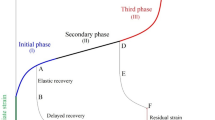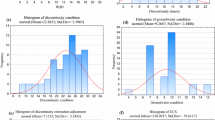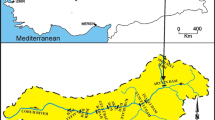Abstract
The elasticity modulus of the rock material (Ei) is a parameter of these developed empirical formulas and is a constant value obtained from laboratory test. The rock material takes different Ei values under different stresses. The deformation modulus of rock mass (Em) is the parameter used in the design of rock structures and reveals the deformation properties of the rock mass. This behavior is affected by rock mass characteristics such as discontinuities, discontinuities properties and groundwater conditions, as well as the properties of rock material, which is the smallest unit of rock masses. The strength and deformation behavior of the rock material directly affect the deformation characteristic of the rock masses. Determination of the Em is done either by in-situ tests or estimates from empirical formulas developed by different researchers. The locations, where rock structures are built, can be different depths and different geological units. In this case, the amount of stress that the same rock structure is exposed at different depths will be different. Therefore, Ei will take different values under different stresses (depending on parameters such as depth, excavation-support geometry). When the Ei value, which varies depending on the depth, is used in the formulas developed by the researchers, different Em values will be calculated against different Ei values. Currently, designs are made with the classical method. In the classical method, the Ei value obtained from the deformability test performed in the laboratory is used in empirical formulas and Em is calculated. These Ei and Em values are fixed values. However, the Em value also changes depending on the stretch. In the new method proposed in this study, it is recommended to use the value of Em, which varies according to the stress conditions. This new method includes a function based on time-stress-deformation-strength was developed to calculate the Ei value, which takes different values at different stresses. The Ei values that can be changed by this function are used in the empirical formulas used in calculating Em. In the projects within the scope of the research, numerical modeling analyzes including the Em values obtained by this time-stress-deformation-strength dependent function and the Em values obtained by the classical method were performed and very important results were obtained.
Article highlights
-
Geotechnical studies have been carried out on different mining and tunnel projects and the rock mass properties have been revealed.
-
Time and stress dependent laboratory tests have been carried out on the rock materials taken from these projects.
-
With these experiments, deformation modules that change depending on time and stress were produced.
-
An empirical formula has been developed to calculate the varying deformation modulus depending on time and stress.
-
This formula was defined as a user defined material for a software (as sub-routine) used in rock structure designs.
-
With this formula, numerical modeling analyzes including varying deformation modules were made and compared with models made with constant deformation module.










Similar content being viewed by others
Explore related subjects
Discover the latest articles, news and stories from top researchers in related subjects.References
Aksoy CO, UyarAKSOY GG, Guney A, Özacar V, Yaman HE (2020) Influence of time-dependency on elastic rock properties under constant load and its effect on tunnel stability. Geomech Eng 20(1):1–7
Aksoy OC, Uyar GG, Utku S, Safak S, Ozacar V (2019) A new integrated method to design of rock structures. Geomech Eng 18(4):339–352
Aksoy CO, Şafak S, Uyar GG, Özacar V (2018a) A new mathematical approach for representing the deformation mechanism of rocks under constant load. Geotech Lett 8:80–90
Aksoy CO, Uyar GG, Şafak S (2018b) A new approach to time-load-deformation-stress hypersurface of rocks to stability analysis of underground openings. Arabian J Geosci 11:101
Barla G, Debernardi D, Sterpi D (2012) Time-dependent modeling of tunnels in squeezing conditions. Int J Geomech 12(6):697–710
Barton N (2002) Some new Q value correlations to assist in site characterization and tunnel design. Int J Rock Mech Min Sci 39:185–216
Bieniawski ZT (1978) Determining rock mass deformability: Experience from case histories. Int J Rock Mech Mineral Sci Geomech Abstract 15:237–247
Blankenship DA, Amadei B, Stickney G (1983) Potential applications of the corejacking test to characterize the mechanical behavior of rock masses. In: Proceedings of 24th U. S. Symposium on Rock Mechanics, Texas A&M University, pp. 335–342.
Brantut N, Heap MJ, Meredith PG, Baud P (2013) Time-dependent cracking and brittle creep in crustal rocks: a review. J Struct Geol 52:7–43
Damjanac B, Fairhurst C (2010) Evidence for a long-term strength threshold in crystalline rock. Rock Mech Rock Eng 43(5):513–531
Chung CK, Jang ER, Baek SH, Jung YH (2014) How contact stiffness and density determine stress-dependent elastic moduli: a micromechanics approach. Granular Matter. https://doi.org/10.1007/s10035-013-0456-2
Clerici A (1993): Indirect determination of the modulus of deformation of rock masses—Case histories. In: Proceedings of the Conf. Eurock 93, pp. 509-517
Coulson J (1979) Suggested methods for determining in situ deformability of rock. Int J Rock Mech Min Sci 16(3):195–214
Damjanac B, Fairhurst C (2010) Evidence for a long-term strength threshold in crystalline rock. Rock Mech Rock Eng 43:513–531
Fahimifar A, Karami M, Fahimifar A (2015) Modifications to an elasto-visco-plastic constitutive model for prediction of creep deformation of rock samples. Soils Found 55(6):1364–1371
Fattahi H, Moradi A (2018) A new approach for estimation of the rock mass deformation modulus: a rock engineering systems-based model. Bull Eng Geol Env 77:363–374
Feldman RF (1972) Factors effecting young’s modulus-porosity relation of hydrated Portland cement compacts. Cem Concr Res 2(4):375–386
Fuente M, Sulem J, Taherzadeh R, Subrin D (2019) Tunneling in Squeezing Ground: Effect of the Excavation Method. Rock Mech Rock Eng. https://doi.org/10.1007/s00603-019-01931-4
Ghabezloo S, Sulem S, Saint-Mare J (2008) Evaluation of a permeability-porosity relationship in a low permeability creeping material using a single transient test. Int J Rock Mech Min Sci. https://doi.org/10.1016/j.ijrmms.2008.10.003
Gokceoglu C, Sonmez H, Kayabasi A (2003) Predicting the deformation moduli of rock masses. Int J Rock Mech Min Sci 40:701–710
Hoek E, Brown ET (1997) Practical estimates of rock mass strength. Int J Rock Mech Min Sci 34(8):1165–1186
Hoek E, Diederichs MS (2006) Empirical estimation of rock mass modulus. Int J Rock Mech Min Sci 43:203–215
Hustrulid W, Hustrulid A (1975) The CSM cell-a borehole device for determination of the modulus of rigidity of rock. In: Proceedings of 15th Symposium on Rock Mechanics, pp 181–225.
Kayabasi A, Gokceoglu C, Ercanoglu M (2003) Estimating the deformation modulus of rock masses: a comparative study. Int J Rock Mech Min Sci 40:55–63
Kulhawy FH (1975) Stress deformation properties of rock and rock discontinuities. Eng Geol 9:327–350
Li YS, Xia CC (2000) Time-dependent tests on intact rocks in uniaxial compression. Int J Rock Mech Min Sci 37(3):467–475
Ljunggren C, Stephansson O (1986) Sleeve fracturing: a borehole technique for in-situ determination of rock demformability and rock stresses. In: International symposium on rock stress and rock stress measurements, pp 323–330
Lo Presti DCF, Jamiolkowski M, Pallara O, Pisciotta V, Ture S (1995) Stress dependence of sand stiffness. International conferences on recent advances in geotechnical earthquake engineering and soil dynamics. 16
Loureiro-Pinto J (1986) Suggested method for deformability determination using a large flat jack technique. Int J Rock Mech Min Sci Geomech Abstr 23(2):133–140
Mitri HS, Edrissi R, Henning J (1994) Finite element modelling of cable-bolted stopes in hardrock ground mines. In: SME Annual Meeting. Albuquerque, New Mexico, pp 94–16
Nicholson GA, Bieniawski ZT (1990) A nonlinear deformation modulus based on rock mass classification. Int J Min Geol Eng 8:181–202
Palmström A (1996) Characterizing rock masses by the RMi for use in practical rock engineering, Part2: some practical applications of the rock mass index (RMi). Tunnell Undergr Space Technol 11:287–303
Palmström A, Singh R (2001) The deformation modulus of rock masses-comparisons between in situ tests and indirect estimates. Tunn Undergr Space Technol 16:115–131
Panek LA, Hornsey EE, Lappi RL (1964) Determination of the modulus of rigidity of rock by expanding a cylindirical pressure cell in a drillhole. In: Proceedings of 6th symposium on rock mechanics, pp 427–449
Ramamurthy T (2004) A geo-engineering classification for rocks and rock masses. Int J Rock Mech Min Sci 41:89–101
Read SAL, Richards LR, Perrin ND (1999) Applicability of the Hoek-Brown failure criterion to New Zealand greywacke rocks. Proc. 9th Int. Cong on Rock Mech Paris 2:655–660
Sefarim JL, Pereira JP (1983) Consideration of the geomechanics classification of Bieniawski. In: Proceedings of international symposium on engineering geology and underground construction, Lisbon, Portugal, pp 1133–1144
Sharma VM, Singh RB, Chaudhary RK (1989) Comparison of different techniques and interpretation of the deformation modulus of rock mass. Proc. Indian Geotechnical Conference (IGC). Visakhapatnam I:439–443
Singh RB, Rajvansi US (1996): Effect of excavation on modulus of deformation. In: Proceedings of the conference on recent advances in tunnelling technology, New Delhi, pp. 57 – 67
Sonmez H, Gokceoglu C, Nefeslioglu HA, Kayabasi A (2006) Estimation of rock modulus: for intact rocks with an artificial neural network and for rock masses with a new empirical equation. Int J Rock Mech Min Sci 43:224–235
Sonmez H, Gokceoglu C, Ulusay R (2004) Indirect determination of the modulus of deformation of rock masses based on the GSI system. Int J Rock Mech Min Sci 41:849–857
Tomanovic Z (2012) The stress and time dependent behaviour of soft rocks. GRAĐEVINAR 64(12):993–1007
Tomanovic Z (2005) Stress dependent modulus of deformability of marl under short term loading (In Serbian). Geotehnicki aspekti gradevinarstva, Savez gradevinskih inzenjera i tehnicara Srbije iCrne Gore, Kopaonik, pp 101–106
Torbica S, Lapcevic V (2019) A model for estimation of stress-dependent deformation modulus of rock mass. Int J Min Geo-Eng (IJMGE) 53(1):63–67
Tsai LS, Hsieh YM, Weng MC, Huang TH, Jeng FS (2008) Time-dependent deformation behaviors of weak sandstones. Int J Rock Mech Min Sci 45(2):144–154
Ulusay S, Sonmez H, Engineering properties of Rock Masses, TMMOB Chamber of Geological Engineering, ISBN: 975-395-466-2, p 155 (In Turkish).
Verman M, Singh B, Viladkar MN, Jethwa JL (1997) Effect of tunnel depth on modulus of deformation of rock mass. Rock Mech Rock Eng 30:121–127
Yang WD, Zhang QY, Li SC, Wang SG (2014) Time-dependent behavior of diabase and a nonlinear creep model. Rock Mech Rock Eng 47:1211–1224
Zhao ZH, Wang WM, Gao X (2014) Evolution laws of strength parameters of soft rock at the post-peak considering stiffness degradation. J Zhejiang Univ Sci A 15:282–290
Acknowledgements
This research was supported by TUBITAK. Project number is 114M566. Authors would like to TUBITAK (The scientific and technological research council of Turkey) to give financial support. And, the authors also would like to thank to Dr. Marilena CARDU for providing to research opputunity in DIATI-Politecnico Di Torino from 01 Februay 2022.
Author information
Authors and Affiliations
Corresponding author
Ethics declarations
Conflıct of interest
The authors declare that they have no known competing financial interests or personal relationships that could have appeared to influence the work reported in this paper.
Additional information
Publisher's Note
Springer Nature remains neutral with regard to jurisdictional claims in published maps and institutional affiliations.
Rights and permissions
About this article
Cite this article
Aksoy, C.O., Aksoy, G.G.U. & Yaman, H.E. The Importance of deformation modulus on design of rocks with numerical modeling. Geomech. Geophys. Geo-energ. Geo-resour. 8, 103 (2022). https://doi.org/10.1007/s40948-022-00380-8
Received:
Accepted:
Published:
DOI: https://doi.org/10.1007/s40948-022-00380-8




